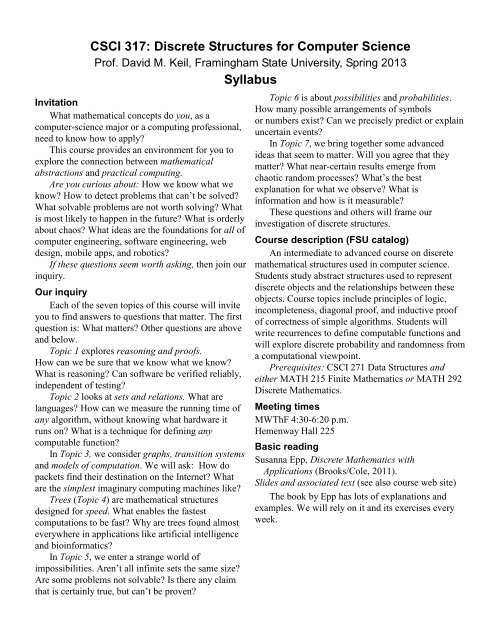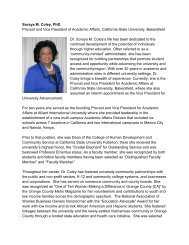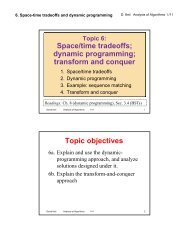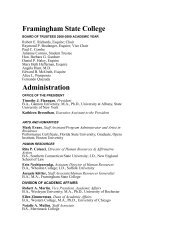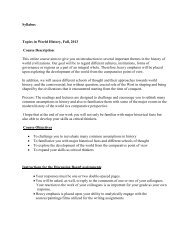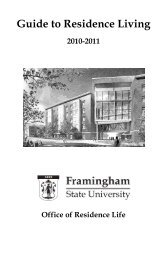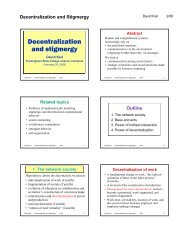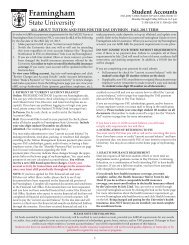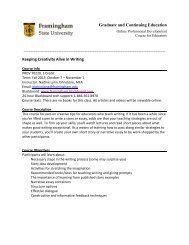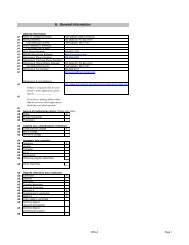CSCI 317: Discrete Structures for Computer Science Syllabus
CSCI 317: Discrete Structures for Computer Science Syllabus
CSCI 317: Discrete Structures for Computer Science Syllabus
You also want an ePaper? Increase the reach of your titles
YUMPU automatically turns print PDFs into web optimized ePapers that Google loves.
<strong>CSCI</strong> <strong>317</strong>: <strong>Discrete</strong> <strong>Structures</strong> <strong>for</strong> <strong>Computer</strong> <strong>Science</strong><br />
Prof. David M. Keil, Framingham State University, Spring 2013<br />
<strong>Syllabus</strong><br />
Invitation<br />
What mathematical concepts do you, as a<br />
computer-science major or a computing professional,<br />
need to know how to apply?<br />
This course provides an environment <strong>for</strong> you to<br />
explore the connection between mathematical<br />
abstractions and practical computing.<br />
Are you curious about: How we know what we<br />
know? How to detect problems that can’t be solved?<br />
What solvable problems are not worth solving? What<br />
is most likely to happen in the future? What is orderly<br />
about chaos? What ideas are the foundations <strong>for</strong> all of<br />
computer engineering, software engineering, web<br />
design, mobile apps, and robotics?<br />
If these questions seem worth asking, then join our<br />
inquiry.<br />
Our inquiry<br />
Each of the seven topics of this course will invite<br />
you to find answers to questions that matter. The first<br />
question is: What matters? Other questions are above<br />
and below.<br />
Topic 1 explores reasoning and proofs.<br />
How can we be sure that we know what we know?<br />
What is reasoning? Can software be verified reliably,<br />
independent of testing?<br />
Topic 2 looks at sets and relations. What are<br />
languages? How can we measure the running time of<br />
any algorithm, without knowing what hardware it<br />
runs on? What is a technique <strong>for</strong> defining any<br />
computable function?<br />
In Topic 3, we consider graphs, transition systems<br />
and models of computation. We will ask: How do<br />
packets find their destination on the Internet? What<br />
are the simplest imaginary computing machines like?<br />
Trees (Topic 4) are mathematical structures<br />
designed <strong>for</strong> speed. What enables the fastest<br />
computations to be fast? Why are trees found almost<br />
everywhere in applications like artificial intelligence<br />
and bioin<strong>for</strong>matics?<br />
In Topic 5, we enter a strange world of<br />
impossibilities. Aren’t all infinite sets the same size?<br />
Are some problems not solvable? Is there any claim<br />
that is certainly true, but can’t be proven?<br />
Topic 6 is about possibilities and probabilities.<br />
How many possible arrangements of symbols<br />
or numbers exist? Can we precisely predict or explain<br />
uncertain events?<br />
In Topic 7, we bring together some advanced<br />
ideas that seem to matter. Will you agree that they<br />
matter? What near-certain results emerge from<br />
chaotic random processes? What’s the best<br />
explanation <strong>for</strong> what we observe? What is<br />
in<strong>for</strong>mation and how is it measurable?<br />
These questions and others will frame our<br />
investigation of discrete structures.<br />
Course description (FSU catalog)<br />
An intermediate to advanced course on discrete<br />
mathematical structures used in computer science.<br />
Students study abstract structures used to represent<br />
discrete objects and the relationships between these<br />
objects. Course topics include principles of logic,<br />
incompleteness, diagonal proof, and inductive proof<br />
of correctness of simple algorithms. Students will<br />
write recurrences to define computable functions and<br />
will explore discrete probability and randomness from<br />
a computational viewpoint.<br />
Prerequisites: <strong>CSCI</strong> 271 Data <strong>Structures</strong> and<br />
either MATH 215 Finite Mathematics or MATH 292<br />
<strong>Discrete</strong> Mathematics.<br />
Meeting times<br />
MWThF 4:30-6:20 p.m.<br />
Hemenway Hall 225<br />
Basic reading<br />
Susanna Epp, <strong>Discrete</strong> Mathematics with<br />
Applications (Brooks/Cole, 2011).<br />
Slides and associated text (see also course web site)<br />
The book by Epp has lots of explanations and<br />
examples. We will rely on it and its exercises every<br />
week.
David Keil <strong>CSCI</strong> <strong>317</strong> <strong>Discrete</strong> <strong>Structures</strong> <strong>for</strong> <strong>Computer</strong> <strong>Science</strong> Framingham State University Spring 2013<br />
To contact me<br />
Office hours (Hemenway Hall 318A):<br />
M 3:30-4:30 p.m.; W 10:30 -11:30 a.m.;<br />
F 9:30-10:20 a.m.; others by appointment<br />
Telephone: (508) 626-4724<br />
Email: dkeil@framingham.edu<br />
URL: www.framingham.edu/~dkeil<br />
Learning objectives<br />
The course is guided by the following objectives:<br />
0a. Participate in class activities throughout<br />
the semester<br />
0b. Solve problems as part of a team<br />
0c. Present results in the classroom<br />
0d. Present written results<br />
0e. Show knowledge of facts and concepts<br />
0f. Summarize the semester’s learning<br />
0g. Relate mathematical concepts to applications<br />
0h. Apply mathematical induction in proofs<br />
1. Explain and apply logical inference<br />
2. Apply set-theoretic concepts, including the<br />
notions of relations, functions, and languages<br />
3. Apply the basic notions of graph theory, including<br />
by means of proof<br />
4. Prove properties of trees, describing their<br />
applications<br />
5. Distinguish countable from uncountable sets,<br />
applying the diagonal proof method in number<br />
theory, logic, and computability<br />
6. Apply the basic notions of combinatorics and<br />
discrete probability, including by proof<br />
7. Explain connections between quantity of<br />
in<strong>for</strong>mation and degree of randomness, comparing<br />
chaotic behavior to random behavior<br />
For other objectives, see topic slides.<br />
This is a computer science course<br />
<strong>Computer</strong> science is a scientific discipline with<br />
empirical and theoretical aspects. This discipline is<br />
concerned with computation, the manipulation of<br />
symbols by machines. <strong>Computer</strong> programming and<br />
architecture are on the practical side. The theoretical<br />
aspect is a branch of mathematics. Its foundation is in<br />
discrete mathematics, the mathematics of logic, sets,<br />
and discrete quantities. This is a discrete math course.<br />
Theoretical results in computer science are<br />
theorems about computations and about data<br />
structures relevant to computation. Theorems are<br />
mathematically proven assertions. For example, you<br />
will see that we can prove that an algorithm works.<br />
The origin of computer science is in logic,<br />
because computers are machines that manipulate<br />
symbols using logic. Every component of a computer<br />
operates on truth values (bits).<br />
This course builds on and applies concepts studied<br />
in discrete mathematics or finite mathematics courses.<br />
When you complete it, you will know some things <strong>for</strong><br />
sure, because you will have proven them.<br />
<strong>Discrete</strong> <strong>Structures</strong> helps prepare <strong>for</strong> work in<br />
verification and analysis of per<strong>for</strong>mance of algorithms<br />
and interactive processes, as well as in <strong>for</strong>mal<br />
languages and models of computation, presented in<br />
presented in <strong>CSCI</strong> 347 (Analysis of Algorithms),<br />
<strong>CSCI</strong> 460 (Theory of Computing), and graduate<br />
courses. It provides a foundation <strong>for</strong> study in artificial<br />
intelligence, bioin<strong>for</strong>matics, and other applied areas.<br />
If you take <strong>Discrete</strong> <strong>Structures</strong> be<strong>for</strong>e Algorithms<br />
or Theory, then it will prepare you exceptionally well<br />
<strong>for</strong> those courses.<br />
Topics and examples in this course are chosen <strong>for</strong><br />
their relevance to application in practical and<br />
theoretical computer science. For example, we focus<br />
on algorithms; on structures on which algorithms<br />
operate, such as graphs; and on the application of<br />
transition systems as models of computation.<br />
Where the course material overlaps with<br />
<strong>CSCI</strong> 347 and <strong>CSCI</strong> 460, the emphasis in <strong>CSCI</strong> <strong>317</strong> is<br />
on the mathematics, especially theorems and proofs;<br />
whereas the emphasis in Algorithms is on design and<br />
time per<strong>for</strong>mance, and in Theory it is on the<br />
computing power of imaginary machines. In this<br />
course, the theorem and proofs are our focus, and in<br />
the other courses the focus is application.<br />
The course is organized partly in a spiral model.<br />
That is, certain themes will be addressed repeatedly in<br />
the course, each time in a different context and at a<br />
more advanced level.<br />
I ordered the topics with the following reasoning.<br />
Logic (topic 1) is the foundation <strong>for</strong> all topics of this<br />
course, including proof methods. Sets and relations<br />
(topic 2) are the underpinning <strong>for</strong> recurrences and<br />
algorithm analysis (topic 2); <strong>for</strong> graphs and transition<br />
systems (topic 3); <strong>for</strong> trees (topic 4), a kind of graph;<br />
and <strong>for</strong> recursively defined functions (topic 5).<br />
Tree concepts (topic 4) are used extensively in<br />
combinatorics and probability (topic 6). Probabilistic,<br />
uncertain processes (topic 6) are the objects of study
David Keil <strong>CSCI</strong> <strong>317</strong> <strong>Discrete</strong> <strong>Structures</strong> <strong>for</strong> <strong>Computer</strong> <strong>Science</strong> Framingham State University Spring 2013<br />
in in<strong>for</strong>mation theory, randomness, and chaos<br />
(topic 7).<br />
Basic or prerequisite skills<br />
It will make a big difference if you have studied<br />
propositional logic; sets; relations; graphs; functions;<br />
statistical functions, such as measures of central<br />
tendency; and programming with arrays and loops.<br />
The following capabilities are prerequisites.<br />
a. Explain or use propositional logic<br />
b. Per<strong>for</strong>m operations on sets<br />
c. Explain what relations are<br />
How the course will deliver what it offers<br />
For each of the eight topics, we will have presentations<br />
by me, discussion, group work, blackboard<br />
work, report backs from each student, and in-class<br />
and out-of-class written exercises. Exercises and<br />
questions help to assess attainment of learning<br />
objectives.<br />
Our classroom environment emphasizes active<br />
inquiry, participation, respect, and support among all<br />
participants. Learning is seen as the interactive<br />
construction of knowledge by the learner. We ask<br />
each other questions and investigate problems<br />
together.<br />
Frequent written exercises and quizzes monitor<br />
progress and enable second chances. To show the<br />
results of student ef<strong>for</strong>ts to learn, we use eight<br />
measures: application of concepts; knowledge of<br />
facts; written contribution; presentation of results in<br />
person; group activity; summary and reflection; and<br />
attendance.<br />
Application of concepts on ten core topic<br />
objectives, as shown in quizzes in class, is the<br />
strongest measure. Students have three opportunities<br />
to show that they have mastered each objective.<br />
I score each item of work, or grading criterion, on a<br />
scale of 0 to 1.0.<br />
The essay, “What we do in my classroom,” is part<br />
of this syllabus. It has detailed guidelines <strong>for</strong><br />
assignments, collaboration, and grading.<br />
Semester project<br />
Each student will summarize the learning in this<br />
course in a project that includes proofs from assigned<br />
work, discusses applicability of some mathematical<br />
results in computer science, and includes research<br />
outside the course materials.<br />
Semester grading weights<br />
Application of concepts<br />
core topic objectives 40<br />
other topic objectives 10<br />
Summary and reflection 10<br />
Knowledge of facts 10<br />
Written exercises 10<br />
Presenting results in person 10<br />
Group activity 5<br />
Attendance 0 5<br />
100 %<br />
Accommodations<br />
“Students with disabilities who request<br />
accommodations are to provide Documentation<br />
Confirmation from the Office of Academic Support<br />
within the first two weeks of class. Academic Support<br />
is located in the Center <strong>for</strong> Academic Support and<br />
Advising (CASA). Please call (508) 626-4906 if you<br />
have questions or if you need to schedule an<br />
appointment.” (See www.framingham.edu/ CASA/<br />
Accommodations/accomm.htm.)
David Keil <strong>CSCI</strong> <strong>317</strong> <strong>Discrete</strong> <strong>Structures</strong> <strong>for</strong> <strong>Computer</strong> <strong>Science</strong> Framingham State University Spring 2013<br />
Course Plan<br />
Dates Topic or activity Readings<br />
1/23 – 1/30 Introduction and discrete-math review Handout; Epp, Ch. 1-4; Sec. 6.4<br />
1/30 – 2/6 1. Boolean algebras, logic, and induction Epp, Sec. 6.1-6.4; handouts<br />
2/11 – 2/13 2. Sets, relations, and recurrences Epp, Ch. 5; Sec. 6.1; Sec. 8.1-8.5;<br />
11.1-11.3; 12.1; handouts<br />
2/20 Quizzes on topics 1-2<br />
2/20 – 2/27 3. Graphs and transition systems Epp, Sec. 10.1-10.4;<br />
Sec. 12.2-12.3<br />
3/4 – 3/11 4. Tree structures and their uses Epp, Sec. 10.5-10.7;<br />
Sec. 11.4-11.5; handouts<br />
3/13 Quizzes on topics 3-4<br />
3/25 – 3/27 5. Countability and decidability Epp, Sec. 6.4; Ch. 7; handouts<br />
3/27 Make-up quizzes on topics 1-4<br />
4/1 – 4/3 6. Combinatorics and discrete probability Epp, Ch. 9; handouts<br />
4/3 Preliminary semester project drafts and reports<br />
4/8 Quiz on topic 5<br />
4/8 – 4/17 7. In<strong>for</strong>mation theory, randomness, and chaos Handouts<br />
4/22 – 4/29 Summary and course review<br />
4/22 Quizzes on topics 6-7<br />
4/29 Make-up quizzes on topics 5-7<br />
5/1 Final exam (problem solving) (Topics 1-7)<br />
Monday, 5/6, 3:00pm Final exam (multiple-choice),<br />
and optional objectives problems


